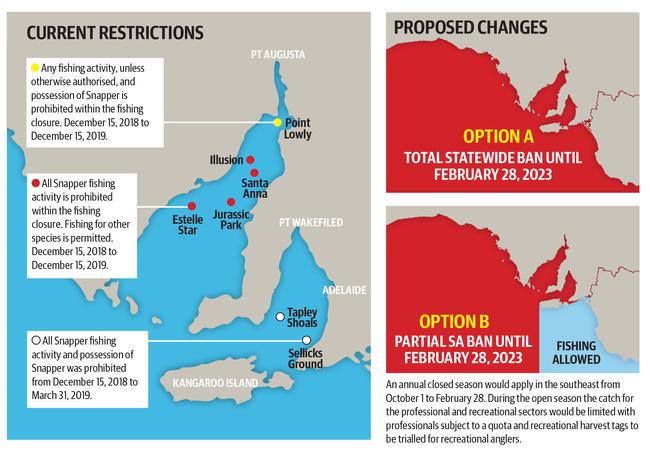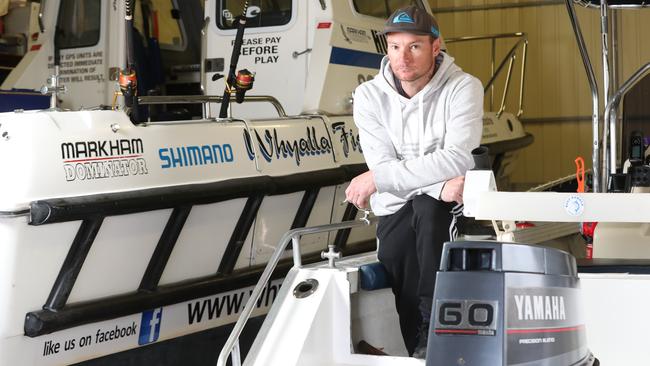Seafood lovers forced to switch species as snapper ban bites from October this year
Seafood lovers will be forced to find an alternative to the much-loved snapper as prices skyrocket when a three-year fishing ban starts in October.

Snapper will become a high-end seafood commodity that few people will be able to afford when a proposed three-year fishing ban comes into force, according to one of SA’s best-known fish retailers.
Cappo’s Fish Market owner Matt Cappo said the high price and scarcity of snapper would force consumers to switch to fish such as NT barramundi or farmed Tasmanian Atlantic salmon.
“The relatively small volume of snapper that will come from the South-East, even if professionals are allowed to fish there, will be in high demand and will be priced accordingly,’’ he said.
“Those who want it will certainly pay a premium for it, if they can find it in our shops at all.’’
At present snapper fillets are around $45kg and whole fish $22kg. Both prices will rise “significantly’’ when supply becomes limited.
While some retailers might source imported snapper from New Zealand, it is also in short supply as most is sold in Victoria and NSW as soon as it lands there.
Victorian-caught snapper, which is in limited supply because of its drastically reduced fishing season, is also snapped up locally.
The State Government on Thursday revealed two drastic options to protect dwindling snapper stocks – a statewide closure for three years, or a closure for all waters except those in the South-East for a restricted period for the next three years. It will select one option following three weeks of public consultation.

Mr Cappo said traditionally in SA whole medium-sized snapper were very popular at Christmas and Easter.
“We sell them throughout the year but people really want them at those times to cook whole for their celebrations, either baked or on the barbecue,’’ he said. “At other times snapper cutlets and fillets are consistent.’’
He said in recent years the price of snapper had risen, forcing many people to purchase other fish.
“There are other species such as ling fish and flathead and the farmed Atlantic salmon and barramundi,’’ he said.
“There are still options there for people to have whole fish, such as the barramundi (and) kingfish, and they are often a little bit cheaper than snapper sometimes.’’
Mr Cappo, who has been buying fish at the Safcol fish market five days a week for the past 30 years, said he had noticed a gradual decline in the volume of snapper being presented for sale.
“You could see this slowly coming over the past eight to 10 years. It was going to come to a head one day,’’ he said.
“I think it was a matter of time, whether we have left it too late I don’t know.’’
He said while less fish were being caught, many professional fishermen had been selling their snapper direct to the Sydney or Melbourne fish markets because they achieved a higher price there.
The Victory Hotel in Sellicks Beach is noted for its seafood, but head chef Patrick White said it had been a struggle to get pink snapper recently.
“I don’t normally cook it at home because it’s quite expensive,” he said.
He said local alternatives included Coorong mulloway or flathead. “Otherwise you have to look at getting barramundi from WA, which we do occasionally.”
Michelle Farinola, from Samtass Seafoods at the Adelaide Central Market, said if pink snapper was not available “there are so many other fish in the ocean”.
“You are not really going to miss it and replenishing stocks is our number one priority,” she said.
Charter boats fear ‘monumental’ failure will devastate their industry
THE South Australian charter boat industry will be “devastated’’ if a proposed three-year ban on catching snapper goes ahead, according to many operators.
Charter Boat Owners Association spokesman Neil McDonald said he was “quite stunned’’ the State Government had presented just two closure options, rather than a range of measures to limit snapper catches for public consultation. He said around 20 per cent of the 86 operators could have survived a year-long closure, but the proposed three-year closure “would mean the end of the industry”.
“We do not accept that they are the only options available,’’ he said.
“If they are, it means we have suffered a monumental management failure and that needs to be fixed.’’
He said the industry would meet to present a “more rational response’’ to the Government to “try to maintain the industry and support the stocks’’.
Whyalla Fishing Charters owner Steve Storic said his business, which only targeted snapper, would be “finished’’ if the closure went ahead.
“People come fishing with me to target Whyalla’s famous big snapper, not other species,’’ he said.

Mr Storic said his business had become more difficult in recent years with large areas closed for fishing, but there were still good numbers of snapper around.
“I disagree 110 per cent with a lot of the statistics that have been put out there by PIRSA. I do not think they are accurate enough to make these claims,’’ he said.
“I don’t seem to have too much trouble here to find snapper all year round.’’
He said he felt the total closure was not the correct path and other measures should have been considered to reduce fishing pressure.
“Charter bag limits have already taken a cut and I think if they took that across the board to the recreational sector as well ... at the end of the day, we can still target our famous species,’’ he said.
“Wiping out the recreational fishing sector which is what SA is famous for is catastrophic, not only for the fishers but businesses and tourism.’’
He said if the snapper fishery was “not sustainable for a commercial fishery, then why have a commercial fishery.’’ Port Hughes Fishing Charters owner Barry Whellum, who is also treasurer of the association, said the decision was “detrimental to the whole industry’’.
“I believe it is the wrong decision – we put submissions to PIRSA that we thought were the right decisions,’’ he said.
“We thought tagging would be the best solution and that the spatial closures that were reopened in Gulf St Vincent last year should have remained closed because they were aggregation zones for breeding.’’
He said closing the fishery for three years would ensure many businesses suffered hardship, not just charter operators.
“It will not only be us to suffer, it will be country towns, tackle shops, caravan parks, the whole box and dice,’’ he said.
Wallaroo-based Captain Cook Fishing Charters owner Ray Cook said his business “will cease’’ if the ban went ahead.
“That is all people want to catch and if they take that away, it will be devastating for us,’’ he said.
Mr Cook, who has been operating for 17 years, blamed prawn trawlers for destroying large areas of natural bottom that snapper once relied on to find food and poor management decisions by PIRSA for the current stock predicament.
